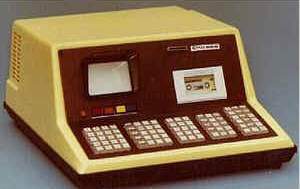EMG 666 calculator
There were actually two versions of the calculator: the 666 and the 666B, but they only differed in the choice of components, and although they also included LSI packages, they were basically built from TTL circuits.
Due to their limited programming capabilities and lack of universality, they can be considered more like calculators, despite their capabilities approaching those of computers.
Own development based on the model released by Wang Laboratories Ltd. in 1971
Use
- Data processing
- Technical and scientific calculations
- Measurement data collection
Structure
Central unit
Word-organized machine, 32 bpW
- controller: built from TTL and MOS LSI elements
- program counter (PC) and instruction register
- 2 index registers
- universal rail system and
- priority interrupt handling logic
- main store:
- 1 KB RAM (112 data registers or 832 instructions)
- 8 KB RAM (1008 data registers or 8000 instructions)
- 2 KW ferrite ring ROM
- calculator:
- 3 adatregiszter (X, Y, Z)
- floating point decimal operation circuits
- channel: bus interfaces
Periphery
- backup storage: built-in cassette recorder (60 Bps)
- external devices:
- 88-key keyboard for data and command input + 4 mode switches
- CRT display (120*90 mm)
- optional narrow matrix printer
Power supply: mains or battery (130 W)
Operation
The machine could be programmed with pushbuttons ("button language"), by calling the built-in (>200) or previously defined (≤ 20) own functions.
The microprogrammed instruction set (firmware) was contained in the ROM memory. Instruction types:
- Control instructions: conditional and conditional jumps, looping, recursive subroutine calls up to 8 times deep
- Data transfer between data registers and main memory, using direct or (chained) indirect addressing; data saving/loading to/from magnetic tape
- Calculation operations: basic operations, logarithm, squaring/square root, exponential and trigonometric functions
Data traffic was carried out directly on the data buses or via up to 15 transceivers (in bidirectional parallel — byte or bit-serial — “handshake” mode).
Data formats:
- 12 decimal (BCD) digit number representation
- floating point mode
- signed absolute value (value set: 1.0×10 -100 ÷ 9.99999999999×10 +98 )
- byte and character strings
Operation times:
- addition, subtraction: 0.3–0.5 ms
- multiplication, division, squaring: 2–6 ms
- square root: approx. 30 ms
- exponential functions: approx. 40 ms
- logarithms: approx. 120 ms
- trigonometric functions, x y: 100–300 ms
Show results:
- the contents of the 3 data registers are in one line each
- displays in 4 lines:
- address counter register
- next instruction code
- other additional (error, keystroke) signals
Program set
There were no
There were no
Historical curiosities
This was the first programmable calculator in the CEEC zone.
Until the release of the HP 9825 calculator, it was the only calculator with hardware interrupts.
Created: 2016.07.13. 19:36
Last modified: 2024.09.05. 17:40

